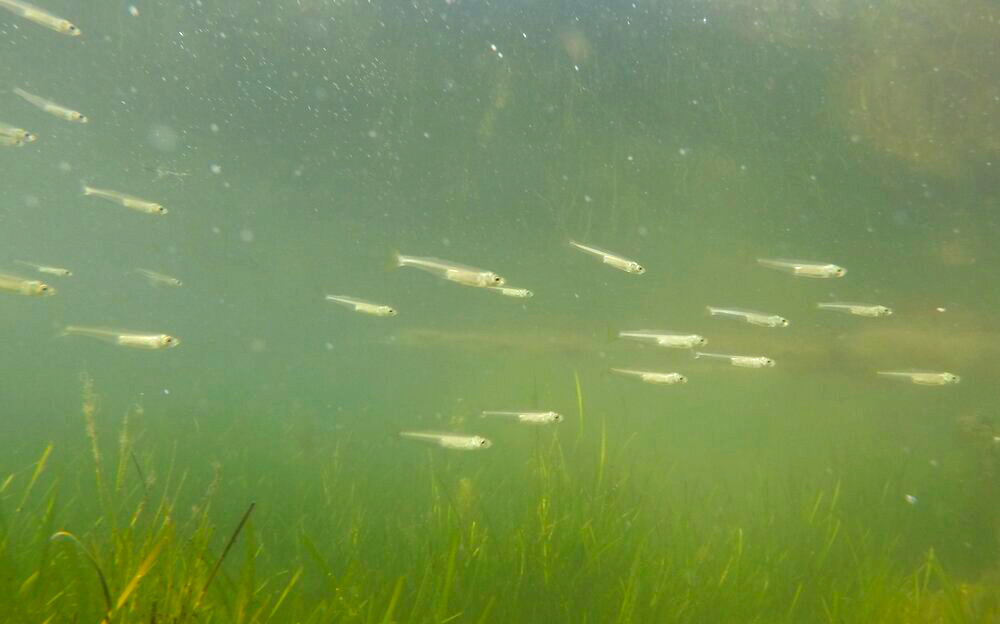Long Island Sound’s Ecosystem Engineers
By Connor Jones
Eelgrass, or Zostera marina, is a type of seagrass found in the estuaries and coastlines of the northern hemisphere. One of 72 species of seagrass found around the world, eelgrass is a true plant (an angiosperm), with roots, stems, leaves, seeds, and of course, flowers! Although they have some similarities, eelgrass and seaweed are not closely related.
Eelgrass reproduces both sexually and asexually. Sexual reproduction occurs through flower production in May or June. Like land plants, eelgrass produces flowers which contain pollen. This pollen is transported through the water with the help of currents until it lands on, and fertilizes, the female part of another eelgrass flower. Fertilized eelgrass flowers develop into seeds which can float for miles before settling on the ocean floor and growing into a new eelgrass plant. Asexual reproduction occurs through growth and elongation of the rhizome, or a long horizontal root-like structure, with multiple vertical shoots that extend above the sea floor into the water column. A common example of a rhizome is fresh ginger that you can find at the grocery store.
Eelgrass needs ample sunlight to grow therefore it is often found growing in shallow, near shore water at depths up to 24 feet. Eelgrass around Fishers Island has been found growing up to 5 feet in length. With sunlight, clean, clear water and appropriate nutrient, temperature, and salinity levels, eelgrass will form extensive underwater meadows. These underwater meadows provide valuable benefits for marine organisms and people. Like all species of seagrass, eelgrass generates oxygen, improves water quality, reduces shoreline erosion by stabilizing sediments and can store twice as much carbon as forests on land.
Seagrass meadows provide habitat for hundreds of species, including recreationally and commercially important fish and shellfish. An eelgrass meadow can be home to hundreds more organisms than an adjacent area of bare sand. Because of their ability to create habitat for so many other species, eelgrasses are often called ‘ecosystem engineers’ (a title shared by corals, beavers and oysters) and seagrasses are federally classified as Essential Fish Habitat (EFH). Other examples of EFH include wetlands and coral reefs.
Within an eelgrass meadow, some species of algae and phytoplankton, referred to as epiphytes, live directly on the leaves, or blades, of seagrass. In turn, snails will crawl along the leaves, feeding on the growing algae, which helps keep the eelgrass blades clean. Even some small anemones grow on the blades. Small fish, like silversides and seahorses, and small invertebrates, such as shrimp, crabs and amphipods, stick close to seagrass meadows, as they offer a place for them to hide from predators.
Eelgrass meadows also act as a nursery for many species of fish and shellfish. Bay scallops, lobsters, winter flounder, summer flounder, tautog, striped bass, black sea bass and bluefish can all be found in eelgrass at various life stages and times of the year. A study by Pohle et al. published in 1991 showed that juvenile bay scallops have higher rates of survival in areas with denser meadows of eelgrass. Some animals, like sea turtles, Canada Geese and Brant (another type of goose) even feed on seagrass leaves.
When eelgrass is protected and conserved, many organisms benefit which in turn benefit coastal communities and economies, like Fishers Island. The island’s eelgrass ecosystem supports commercial and recreational fishing opportunities. The beaches of Fishers Island are protected from storms by the eelgrass meadows just offshore that absorb the resulting wave energy. Without the 347 acres of eelgrass that surrounds us, Fishers Island could be a very different place.



